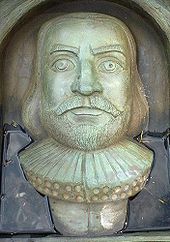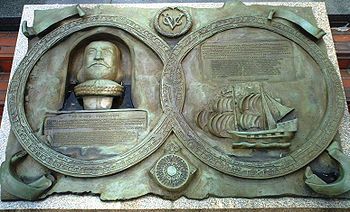
Jan Joosten van Lodensteijn
Encyclopedia

Delft
Delft is a city and municipality in the province of South Holland , the Netherlands. It is located between Rotterdam and The Hague....
and one of the first Dutchmen
Netherlands
The Netherlands is a constituent country of the Kingdom of the Netherlands, located mainly in North-West Europe and with several islands in the Caribbean. Mainland Netherlands borders the North Sea to the north and west, Belgium to the south, and Germany to the east, and shares maritime borders...
in Japan
Japan
Japan is an island nation in East Asia. Located in the Pacific Ocean, it lies to the east of the Sea of Japan, China, North Korea, South Korea and Russia, stretching from the Sea of Okhotsk in the north to the East China Sea and Taiwan in the south...
, arriving as one of William Adams
William Adams (sailor)
William Adams , also known in Japanese as Anjin-sama and Miura Anjin , was an English navigator who travelled to Japan and is believed to be the first Englishman ever to reach that country...
's shipmates (the second mate) on the De Liefde, which was disabled on the coast of Kyūshū
Kyushu
is the third largest island of Japan and most southwesterly of its four main islands. Its alternate ancient names include , , and . The historical regional name is referred to Kyushu and its surrounding islands....
in 1600.
Early life in Japan
The De Liefde departed RotterdamRotterdam
Rotterdam is the second-largest city in the Netherlands and one of the largest ports in the world. Starting as a dam on the Rotte river, Rotterdam has grown into a major international commercial centre...
in 1598, on a trading voyage and attempted a circumnavigation of the globe. It was wrecked in Japan in 1600. The 24 survivors were received by future Shogun
Shogun
A was one of the hereditary military dictators of Japan from 1192 to 1867. In this period, the shoguns, or their shikken regents , were the de facto rulers of Japan though they were nominally appointed by the emperor...
Tokugawa Ieyasu
Tokugawa Ieyasu
was the founder and first shogun of the Tokugawa shogunate of Japan , which ruled from the Battle of Sekigahara in 1600 until the Meiji Restoration in 1868. Ieyasu seized power in 1600, received appointment as shogun in 1603, abdicated from office in 1605, but...
, who questioned them at length on European politics and foreign affairs. As with William Adams, Joosten was selected to be a confidant of the Shogun on foreign and military affairs, and he contributed to the development of relations between the Netherlands and Japan, thereby weakening the influence of Portugal
Portugal
Portugal , officially the Portuguese Republic is a country situated in southwestern Europe on the Iberian Peninsula. Portugal is the westernmost country of Europe, and is bordered by the Atlantic Ocean to the West and South and by Spain to the North and East. The Atlantic archipelagos of the...
and Spain
Spain
Spain , officially the Kingdom of Spain languages]] under the European Charter for Regional or Minority Languages. In each of these, Spain's official name is as follows:;;;;;;), is a country and member state of the European Union located in southwestern Europe on the Iberian Peninsula...
.
For his services, Jan Joosten was granted a house in Edo
Edo
, also romanized as Yedo or Yeddo, is the former name of the Japanese capital Tokyo, and was the seat of power for the Tokugawa shogunate which ruled Japan from 1603 to 1868...
(now Tokyo
Tokyo
, ; officially , is one of the 47 prefectures of Japan. Tokyo is the capital of Japan, the center of the Greater Tokyo Area, and the largest metropolitan area of Japan. It is the seat of the Japanese government and the Imperial Palace, and the home of the Japanese Imperial Family...
) in a part of the city that came to be called "Yayosu Quay" after him — his name was pronounced yan yōsuten in Japanese
Japanese language
is a language spoken by over 130 million people in Japan and in Japanese emigrant communities. It is a member of the Japonic language family, which has a number of proposed relationships with other languages, none of which has gained wide acceptance among historical linguists .Japanese is an...
(short: Yayōsu (耶楊子)) — and the name exists in the name of Yaesu
Yaesu
is a neighborhood in Chūō, Tokyo, Japan, located north of Ginza, west of Nihonbashi and Kyōbashi, and adjacent to the east side of Tokyo Station. The Yaesu exit, which faces Nihonbashi, is recent and primarily provides access to the Shinkansen platforms.-History:...
side of Tokyo Station
Tokyo Station
is a train station located in the Marunouchi business district of Chiyoda, Tokyo, Japan, near the Imperial Palace grounds and the Ginza commercial district....
. Although not allowed to return to the Netherlands, Joosten was allowed to take a Japanese wife and was given a permit to engage in foreign trade. He was privileged to wear the two swords of the samurai
Samurai
is the term for the military nobility of pre-industrial Japan. According to translator William Scott Wilson: "In Chinese, the character 侍 was originally a verb meaning to wait upon or accompany a person in the upper ranks of society, and this is also true of the original term in Japanese, saburau...
and received an annual stipend which placed him (along with Adams) among the ranks of the hatamoto
Hatamoto
A was a samurai in the direct service of the Tokugawa shogunate of feudal Japan. While all three of the shogunates in Japanese history had official retainers, in the two preceding ones, they were referred to as gokenin. However, in the Edo period, hatamoto were the upper vassals of the Tokugawa...
or direct retainers of the Shogun. Joosten was said to be a drunk with a choleric temperament, and at one point was not welcome at Ieyasu's court.
Trading
Joosten is reported to have made a fortune in trade between Japan and Southeast AsiaSoutheast Asia
Southeast Asia, South-East Asia, South East Asia or Southeastern Asia is a subregion of Asia, consisting of the countries that are geographically south of China, east of India, west of New Guinea and north of Australia. The region lies on the intersection of geological plates, with heavy seismic...
, chartering several Red Seal Ships
Red seal ships
were Japanese armed merchant sailing ships bound for Southeast Asian ports with a red-sealed patent issued by the early Tokugawa shogunate in the first half of the 17th century...
under license from Tokugawa Ieyasu. He was reported by Dutch traders in Ayutthaya
Ayutthaya kingdom
Ayutthaya was a Siamese kingdom that existed from 1350 to 1767. Ayutthaya was friendly towards foreign traders, including the Chinese, Vietnamese , Indians, Japanese and Persians, and later the Portuguese, Spanish, Dutch and French, permitting them to set up villages outside the walls of the...
to be aboard junks carrying rich cargoes in early 1613. After the establishment of the Dutch Factory in Hirado
Hirado, Nagasaki
is a city in Nagasaki Prefecture, Japan. The part historically named Hirado is located on the island of the same name. With recent mergers, the city's boundaries have expanded, and Hirado now occupies parts of the main island of Kyūshū...
, he became a middleman between Dutch merchants and the Shogunate.

Tenjiku Tokubei
Tenjiku Tokubei was a Japanese adventurer and writer of the early 17th century. He traveled to Southeast and South Asia, hence his "Tenjiku" nickname....
. Later, he attempted to return to the Netherlands, but after reaching Batavia, he was denied permission by Dutch authorities to proceed further. He drowned in the South China Sea
South China Sea
The South China Sea is a marginal sea that is part of the Pacific Ocean, encompassing an area from the Singapore and Malacca Straits to the Strait of Taiwan of around...
in 1623 when his ship sank as he was returning to Japan.

